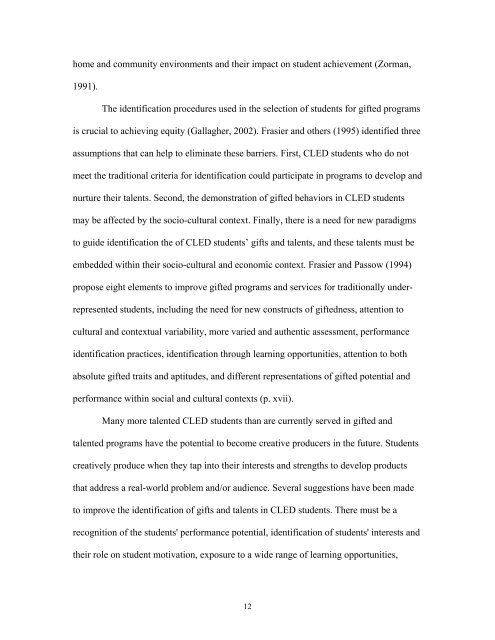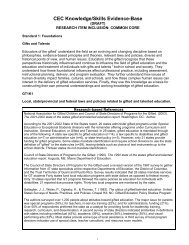Chapter One An Introduction to the Topic of Cultural Diversity - NAGC
Chapter One An Introduction to the Topic of Cultural Diversity - NAGC
Chapter One An Introduction to the Topic of Cultural Diversity - NAGC
Create successful ePaper yourself
Turn your PDF publications into a flip-book with our unique Google optimized e-Paper software.
home and community environments and <strong>the</strong>ir impact on student achievement (Zorman,<br />
1991).<br />
The identification procedures used in <strong>the</strong> selection <strong>of</strong> students for gifted programs<br />
is crucial <strong>to</strong> achieving equity (Gallagher, 2002). Frasier and o<strong>the</strong>rs (1995) identified three<br />
assumptions that can help <strong>to</strong> eliminate <strong>the</strong>se barriers. First, CLED students who do not<br />
meet <strong>the</strong> traditional criteria for identification could participate in programs <strong>to</strong> develop and<br />
nurture <strong>the</strong>ir talents. Second, <strong>the</strong> demonstration <strong>of</strong> gifted behaviors in CLED students<br />
may be affected by <strong>the</strong> socio-cultural context. Finally, <strong>the</strong>re is a need for new paradigms<br />
<strong>to</strong> guide identification <strong>the</strong> <strong>of</strong> CLED students’ gifts and talents, and <strong>the</strong>se talents must be<br />
embedded within <strong>the</strong>ir socio-cultural and economic context. Frasier and Passow (1994)<br />
propose eight elements <strong>to</strong> improve gifted programs and services for traditionally underrepresented<br />
students, including <strong>the</strong> need for new constructs <strong>of</strong> giftedness, attention <strong>to</strong><br />
cultural and contextual variability, more varied and au<strong>the</strong>ntic assessment, performance<br />
identification practices, identification through learning opportunities, attention <strong>to</strong> both<br />
absolute gifted traits and aptitudes, and different representations <strong>of</strong> gifted potential and<br />
performance within social and cultural contexts (p. xvii).<br />
Many more talented CLED students than are currently served in gifted and<br />
talented programs have <strong>the</strong> potential <strong>to</strong> become creative producers in <strong>the</strong> future. Students<br />
creatively produce when <strong>the</strong>y tap in<strong>to</strong> <strong>the</strong>ir interests and strengths <strong>to</strong> develop products<br />
that address a real-world problem and/or audience. Several suggestions have been made<br />
<strong>to</strong> improve <strong>the</strong> identification <strong>of</strong> gifts and talents in CLED students. There must be a<br />
recognition <strong>of</strong> <strong>the</strong> students' performance potential, identification <strong>of</strong> students' interests and<br />
<strong>the</strong>ir role on student motivation, exposure <strong>to</strong> a wide range <strong>of</strong> learning opportunities,<br />
12

















